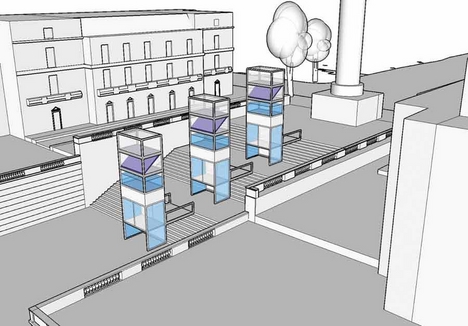I have been slow to update this blog lately-- oh, the cycle of academic work and procrastination and guilt!
But here is what I've been working on..
The main work I have been doing lately is about the do-it-yourself and small-production technical work for and by people with disabilities during the 1950s-60s. This time period, I find, is interesting for the history of disability-related design because it is a kind of transition time: on the one hand, people with severe physical disabilities (spinal cord injuries, cerebral palsy, polio) were more and more likely to live long and healthy lives with mobility impairments. Medical professionals and policy groups advocated "independent living" as a better choice for recovery and social order, but living in homes and communities was not so easy for folks who used wheelchairs, canes, crutches, respirators, and had manual disabilities. As a result, a variety of gadgets and gizmos appeared to bridge the gap between the ambitions and interests of people with disabilities and the world that was not designed well for them.
A lot of these were published by doctors or other rehabilitation experts as part of an effort to ease the transition from clinic to home, like Howard Rusk and Eugene Taylor's Living With a Disability (Blakiston Co, 1953), which featured low-tech options as make-your-own utensils with secure straps: (image: black-and-white image shows forks and spoons with metal straps and finger sheaths attached to their handles, scattered on a black ground)
(image: black-and-white image shows forks and spoons with metal straps and finger sheaths attached to their handles, scattered on a black ground)
Rusk and Taylor also acknowledged the potential usefulness of new materials and gadgets of the postwar consumer culture, such as children's drink cups (aka sippy-cups) and electric razors.


(images: two layouts from Rusk and Taylor's book, with black-and-white images laid out around text. Left, three cups: one white plastic cup with a handle, one clear plastic with a white lid and with a hole and a straw, and one with and hand holding a cup with an attached metal handle with a large loop. There is also a clear plastic saucer on the page.
Right, a two-page layout with men shaving with electric razors: one uses a prosthetic hand, while the others hold handles and loops attached to the appliances.)These kinds of technical fixes for day-to-day independent living also featured heavily in the content of the
Toomey J Gazette, a publication "for by and about respiratory polios" that ran from 1958-1969 (before it became the Rehabilitation Gazette). The Toomey J allowed contributors a forum to share very personalized, creative approaches to making their mid-century home life work for wheelchair, respirator, and rocking bed living. The solutions were wide-ranging and sometimes fanciful, like:
 (image: an ink drawing of an array of different mouthstick designs, each attributed to its designer. Splayed out in a fan from a central pair of lips, the materials include eye-dropper tips with dowels stuck in them, cigarette holders, even the rubber heel of a child's or doll's shoe to be held in the teeth. From the Toomey J Gazette, Spring 1960.
(image: an ink drawing of an array of different mouthstick designs, each attributed to its designer. Splayed out in a fan from a central pair of lips, the materials include eye-dropper tips with dowels stuck in them, cigarette holders, even the rubber heel of a child's or doll's shoe to be held in the teeth. From the Toomey J Gazette, Spring 1960.)
Other contributions were more technical, like a Citroen 2 CV that had been cut up to make a flatbed platform for driving in a wheelchair: the car was equipped with two sets of hand controls and a swiveling floor so that the driver could turn around to drive in reverse, rather than having to crane his neck.
 (image: three newsprint images of Fred Taberlet and his Citroen, a convertible-top car with an open space for driver and his wheelchair.
(image: three newsprint images of Fred Taberlet and his Citroen, a convertible-top car with an open space for driver and his wheelchair.)
In my dissertation, I write about these adaptations, adjustments, and inventions as part of the broader social context for the disability rights movement: this homespun work is a tacit assertion of the right for people with disabilities to operate and move within mainstream American spaces-- the "right to be in the world" that
Jacobus tenBroek declared in a 1966 essay in the California Law Review.
I'll be talking about this research in two upcoming conference talks:
Technocultures and Identity Conference (Mid-America American Studies Association meeting)
Center for Ethnic Studies and the Arts, The University of Iowa
Friday, April 3, 12:30 pm
Panel: Medical Technologies and Identity
Kirkwood Room, 257 IMU
Chair: Michael Krysko (Kansas State)
“Chemical Technology and Emerging Identities: The Role of Technology
and Rhetoric in the Construction of the Hyperactive Child,” Jonathan
Hansen (Iowa)
“Technology and Disability Identity: The Toomey J. Gazette, 1959-1969,”
Bess Williamson (Delaware)
Material Culture Symposium for Emerging ScholarsWinterthur Museum, Wilmington, DE
Saturday, April 25, 3 pm
Panel: The Private Lives of Public Objects
Emily Voss, Cooperstown Graduate Program (Museum Studies)
"Astronauts, Aliens, Rockets, and Ray Guns: Space Toys and American Children 1950-1977"
Bess Williamson, University of Delaware (History of American Civilization)
"Doing It Themselves: Gadgets for and by People with Disabilities, 1945-1970"Drew Sawyer, Columbia University (Art History and Archaeology)
"The Queer Life of Crisco"Commentator: Peter Stallybrass, Professor in the Humanities and Professor of English and of Comparative Literature and Literary Theory, University of Pennsylvania

 Image: Computer drawing of the three-tiered Duke of York steps, with the mock-ups of three glass towers installed on the landings to house wheelchair lifts.
Image: Computer drawing of the three-tiered Duke of York steps, with the mock-ups of three glass towers installed on the landings to house wheelchair lifts.























